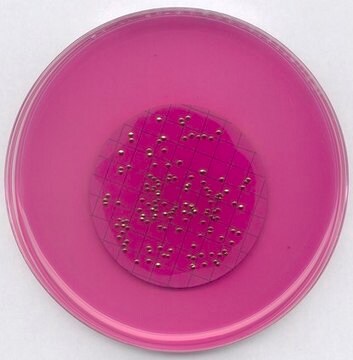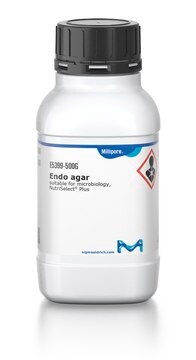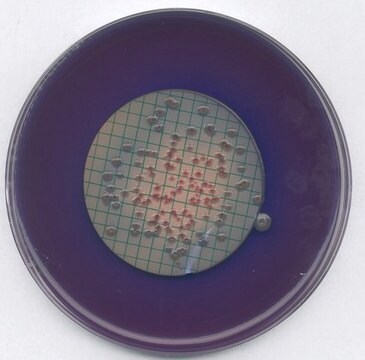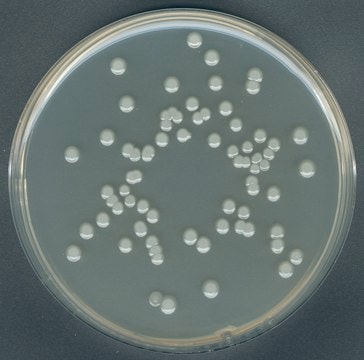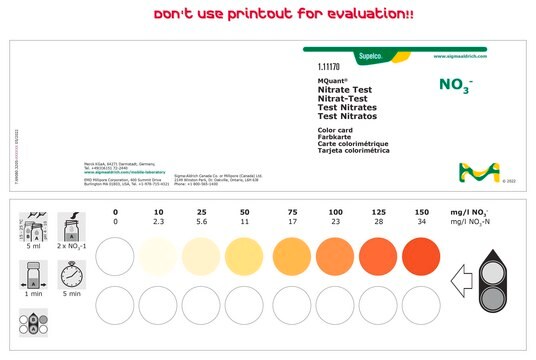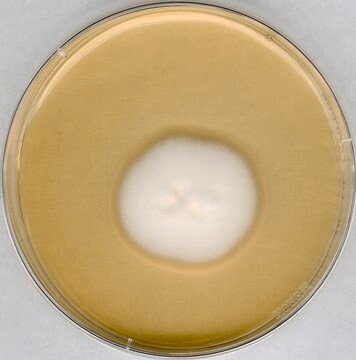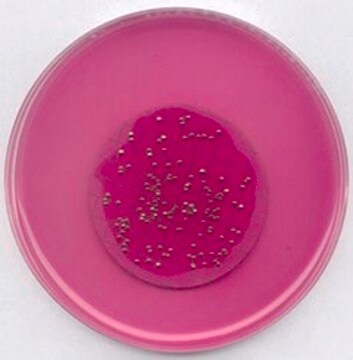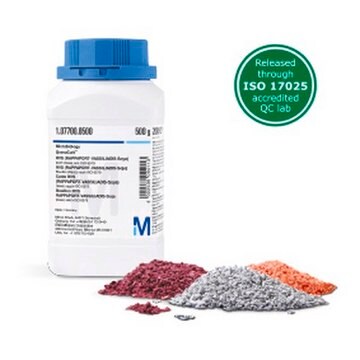1.04044
GranuCult® ENDO agar
for Escherichia coli, for coliforms, suitable for microbiology
Synonyme(s) :
Coliform selective medium, Endo C agar, Fuchsin lactose agar acc. to ENDO
About This Item
Produits recommandés
Agence
according to ENDO
Niveau de qualité
Stérilité
non-sterile
Forme
granular
Conditionnement
pkg of 500 g
Fabricant/nom de marque
GranuCult® plus
Technique(s)
microbiological culture: suitable
Couleur
red-violet
pH
7.2-7.6 (37 °C, 39 g/L in H2O, after autoclaving)
Solubilité
39 g/L
Masse volumique apparente
700 kg/m3
Application(s)
food and beverages
microbiology
Température de stockage
15-25°C
Adéquation
Escherichia coli
coliforms
Catégories apparentées
Description générale
Application
Caractéristiques et avantages
- GranuCult® offers superior granulated culture media.
- Safe and sustainable due to reduced risks associated with fine dust and toxic substance inhalation, resulting in a safer work environment.
- Excellent wettability, solubility, and free-flowing properties
- Convenient, with minimal component separation and clumping, even under warm or humid conditions.
- High batch-to-batch reproducibility
- Prolonged shelf life of up to five years
- High number of test strains exceeding all regulatory demands
- Granulation technology allows many supplements to be included, with no need to add these separately
Stockage et stabilité
Remarque sur l'analyse
Appearance (colour): pink/red
pH-value (25 °C): 7.2 - 7.6
Growth (Escherichia coli ATCC 25922 (WDCM 00013)): good to very good
Growth (Escherichia coli 194): good to very good
Growth (Escherichia coli ATCC 11775 (WDCM 00090)): good to very good
Growth (Enterobacter cloacae ATCC 13047 (WDCM 00083)): good to very good
Growth (Klebsiella pneumoniae ATCC 13883 (WDCM 00097)): good to very good
Growth (Salmonella typhimurium ATCC 14028 (WDCM 00031)): good to very good
Growth (Shigella flexneri ATCC 12022 (WDCM 00126)): good to very good
Growth (Proteus mirabilis ATCC 14153): good to very good
Growth (Enterococcus faecalis ATCC 11700): none to fair
Red colonies (Escherichia coli ATCC 25922 (WDCM 00013)): +
Red colonies (Escherichia coli 194): +
Red colonies (Escherichia coli ATCC 11775 (WDCM 00090)): +
Red colonies (Enterobacter cloacae ATCC 13047 (WDCM 00083)): +(poor)
Red colonies (Klebsiella pneumoniae ATCC 13883 (WDCM 00097)): +
Red colonies (Salmonella typhimurium ATCC 14028 (WDCM 00031)): -
Red colonies (Shigella flexneri ATCC 12022 (WDCM 00126)): -
Red colonies (Proteus mirabilis ATCC 14153): -
Metallic lustre (Escherichia coli ATCC 25922 (WDCM 00013)): +
Metallic lustre (Escherichia coli 194): +
Metallic lustre (Escherichia coli ATCC 11775 (WDCM 00090)): +(poor)
Metallic lustre (Enterobacter cloacae ATCC 13047 (WDCM 00083)): - or poor
Metallic lustre (Klebsiella pneumoniae ATCC 13883 (WDCM 00097)): -
Metallic lustre (Salmonella typhimurium ATCC 14028 (WDCM 00031)): -
Metallic lustre (Shigella flexneri ATCC 12022 (WDCM 00126)): -
Metallic lustre (Proteus mirabilis ATCC 14153): -
Incubation: 24 hrs. 35 °C
Autres remarques
- The plates are clear and pale pink.
- If the culture medium is somewhat red after it has solidified, the red coloration can be removed by adding a few drops (max. 1 mL/liter) of a freshly prepared 10 % sodium sulfite solution and then boiling.
- On exposure to oxygen, the plated culture medium gradually becomes red due to the oxidation of sulfite and can thus no longer be used. It can only be kept for a few days even if it is stored in the dark and at refrigerator temperature.
Note de bas de page
The designations basic, plus, or prime are added to indicate the quality control level, from basic quality control to standard QC plus to prime for full regulatory compliance.
Informations légales
En option
Mention d'avertissement
Danger
Mentions de danger
Conseils de prudence
Classification des risques
Carc. 1B
Code de la classe de stockage
6.1C - Combustible, acute toxic Cat.3 / toxic compounds or compounds which causing chronic effects
Classe de danger pour l'eau (WGK)
WGK 3
Certificats d'analyse (COA)
Recherchez un Certificats d'analyse (COA) en saisissant le numéro de lot du produit. Les numéros de lot figurent sur l'étiquette du produit après les mots "Lot" ou "Batch".
Déjà en possession de ce produit ?
Retrouvez la documentation relative aux produits que vous avez récemment achetés dans la Bibliothèque de documents.
Notre équipe de scientifiques dispose d'une expérience dans tous les secteurs de la recherche, notamment en sciences de la vie, science des matériaux, synthèse chimique, chromatographie, analyse et dans de nombreux autres domaines..
Contacter notre Service technique